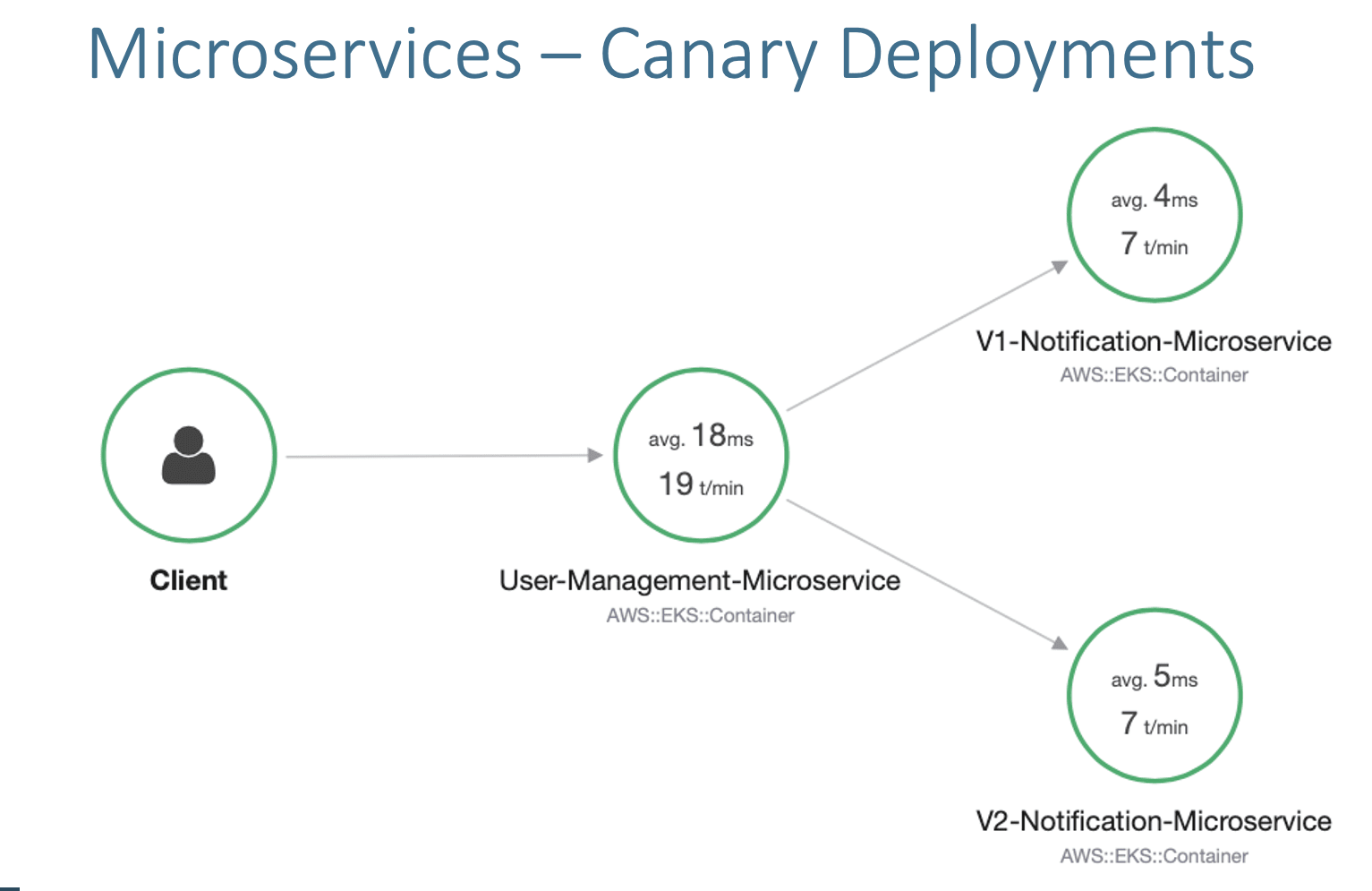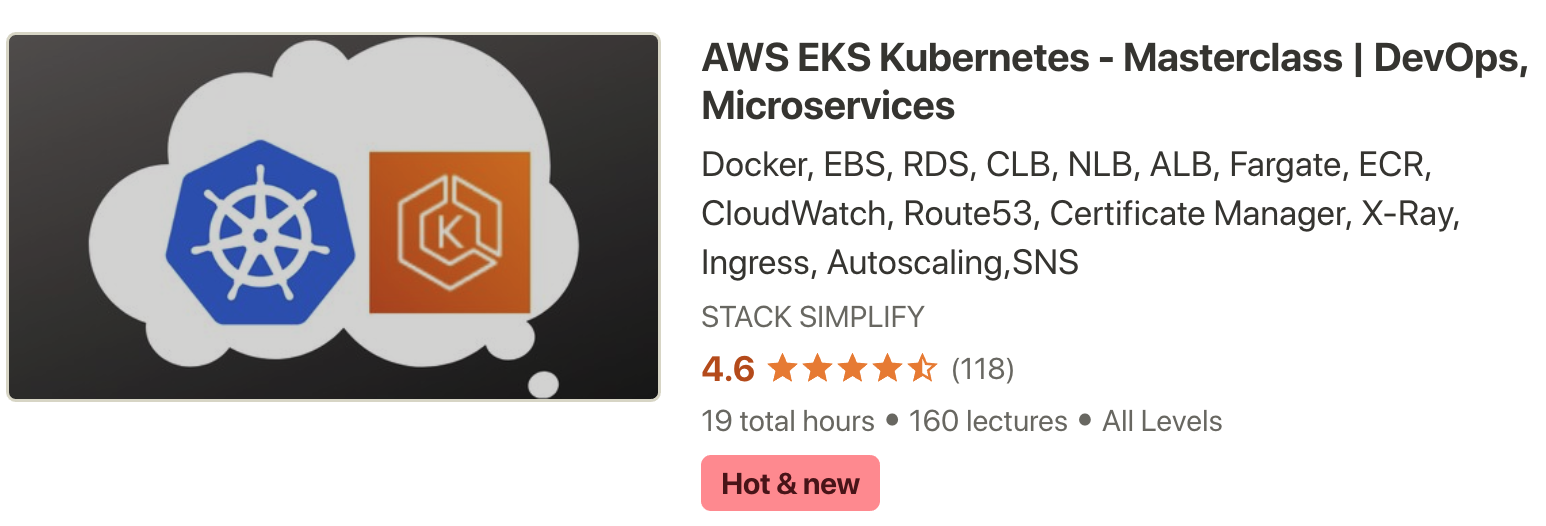#01-MySQL-externalName-Service.yml
apiVersion: v1
kind: Service
metadata:
name: mysql
spec:
type: ExternalName
externalName: usermgmtdb.cxojydmxwly6.us-east-1.rds.amazonaws.com
#02-UserManagementMicroservice-Deployment.yml
apiVersion: apps/v1
kind: Deployment
metadata:
name: usermgmt-microservice
labels:
app: usermgmt-restapp
spec:
replicas: 1
selector:
matchLabels:
app: usermgmt-restapp
template:
metadata:
labels:
app: usermgmt-restapp
spec:
initContainers:
- name: init-db
image: busybox:1.31
command: ['sh', '-c', 'echo -e "Checking for the availability of MySQL Server deployment"; while ! nc -z mysql 3306; do sleep 1; printf "-"; done; echo -e " >> MySQL DB Server has started";']
containers:
- name: usermgmt-restapp
image: stacksimplify/kube-usermanagement-microservice:3.0.0-AWS-XRay-MySQLDB
ports:
- containerPort: 8095
imagePullPolicy: Always
env:
- name: DB_HOSTNAME
value: "mysql"
- name: DB_PORT
value: "3306"
- name: DB_NAME
value: "usermgmt"
- name: DB_USERNAME
value: "dbadmin"
- name: DB_PASSWORD
valueFrom:
secretKeyRef:
name: mysql-db-password
key: db-password
- name: NOTIFICATION_SERVICE_HOST
value: "notification-clusterip-service"
- name: NOTIFICATION_SERVICE_PORT
value: "8096"
- name: AWS_XRAY_TRACING_NAME
value: "User-Management-Microservice"
- name: AWS_XRAY_DAEMON_ADDRESS
value: "xray-service.default:2000"
- name: AWS_XRAY_CONTEXT_MISSING
value: "LOG_ERROR" # Log an error and continue, Ideally RUNTIME_ERROR – Throw a runtime exception which is default option if not configured
livenessProbe:
exec:
command:
- /bin/sh
- -c
- nc -z localhost 8095
initialDelaySeconds: 60
periodSeconds: 10
readinessProbe:
httpGet:
path: /usermgmt/health-status
port: 8095
initialDelaySeconds: 60
periodSeconds: 10
---
# Kubernetes Secrets
apiVersion: v1
kind: Secret
metadata:
name: mysql-db-password
#type: Opaque means that from kubernetes's point of view the contents of this Secret is unstructured, it can contain arbitrary key-value pairs. In contrast, there is the Secret storing ServiceAccount credentials, or the ones used as ImagePullSecret . These have a constrained contents.
type: Opaque
data:
# Output of echo -n 'dbpassword11' | base64
db-password: ZGJwYXNzd29yZDEx
#03-UserManagement-NodePort-Service.yml
apiVersion: v1
kind: Service
metadata:
name: usermgmt-restapp-nodeport-service
labels:
app: usermgmt-restapp
annotations:
#Important Note: Need to add health check path annotations in service level if we are planning to use multiple targets in a load balancer
alb.ingress.kubernetes.io/healthcheck-path: /usermgmt/health-status
spec:
type: NodePort
selector:
app: usermgmt-restapp
ports:
- port: 8095
targetPort: 8095
#04-NotificationMicroservice-Deployment.yml
apiVersion: apps/v1
kind: Deployment
metadata:
name: v1-notification-microservice
labels:
app: notification-restapp
track: stable
spec:
replicas: 1
selector:
matchLabels:
app: notification-restapp
template:
metadata:
labels:
app: notification-restapp
track: stable
spec:
containers:
- name: notification-service
image: stacksimplify/kube-notifications-microservice:3.0.0-AWS-XRay
ports:
- containerPort: 8096
imagePullPolicy: Always
env:
- name: AWS_MAIL_SERVER_HOST
value: "smtp-service"
- name: AWS_MAIL_SERVER_USERNAME
value: "AKIASUF7HC7SQJ6BCLVS"
- name: AWS_MAIL_SERVER_PASSWORD
value: "BARcmLiC68wgmhTy/cQvz/E8vFzeizGqdeASNtCs6+Nv"
- name: AWS_MAIL_SERVER_FROM_ADDRESS
value: "stacksimplify@gmail.com"
- name: AWS_XRAY_TRACING_NAME
value: "V1-Notification-Microservice"
- name: AWS_XRAY_DAEMON_ADDRESS
value: "xray-service.default:2000"
- name: AWS_XRAY_CONTEXT_MISSING
value: "LOG_ERROR" # Log an error and continue, Ideally RUNTIME_ERROR – Throw a runtime exception which is default option if not configured
#05-NotificationMicroservice-SMTP-externalName-Service.yml
apiVersion: v1
kind: Service
metadata:
name: smtp-service
spec:
type: ExternalName
externalName: email-smtp.us-east-1.amazonaws.com
#06-NotificationMicroservice-ClusterIP-Service.yml
apiVersion: v1
kind: Service
metadata:
name: notification-clusterip-service
labels:
app: notification-restapp
spec:
type: ClusterIP
selector:
app: notification-restapp
ports:
- port: 8096
targetPort: 8096
#07-ALB-Ingress-SSL-Redirect-ExternalDNS.yml
# Annotations Reference: https://kubernetes-sigs.github.io/aws-alb-ingress-controller/guide/ingress/annotation/
apiVersion: extensions/v1beta1
kind: Ingress
metadata:
name: eks-microservices-demo
labels:
app: usermgmt-restapp
annotations:
# Ingress Core Settings
kubernetes.io/ingress.class: "alb"
alb.ingress.kubernetes.io/scheme: internet-facing
# Health Check Settings
alb.ingress.kubernetes.io/healthcheck-protocol: HTTP
alb.ingress.kubernetes.io/healthcheck-port: traffic-port
alb.ingress.kubernetes.io/healthcheck-interval-seconds: '15'
alb.ingress.kubernetes.io/healthcheck-timeout-seconds: '5'
alb.ingress.kubernetes.io/success-codes: '200'
alb.ingress.kubernetes.io/healthy-threshold-count: '2'
alb.ingress.kubernetes.io/unhealthy-threshold-count: '2'
## SSL Settings
alb.ingress.kubernetes.io/listen-ports: '[{"HTTPS":443}, {"HTTP":80}]'
alb.ingress.kubernetes.io/certificate-arn: arn:aws:acm:us-east-1:180789647333:certificate/9f042b5d-86fd-4fad-96d0-c81c5abc71e1
#alb.ingress.kubernetes.io/ssl-policy: ELBSecurityPolicy-TLS-1-1-2017-01 #Optional (Picks default if not used)
# SSL Redirect Setting
alb.ingress.kubernetes.io/actions.ssl-redirect: '{"Type": "redirect", "RedirectConfig": { "Protocol": "HTTPS", "Port": "443", "StatusCode": "HTTP_301"}}'
# External DNS - For creating a Record Set in Route53
external-dns.alpha.kubernetes.io/hostname: services.kubeoncloud.com, ums.kubeoncloud.com
spec:
rules:
- http:
paths:
- path: /* # SSL Redirect Setting
backend:
serviceName: ssl-redirect
servicePort: use-annotation
- path: /*
backend:
serviceName: usermgmt-restapp-nodeport-service
servicePort: 8095
# Important Note-1: In path based routing order is very important, if we are going to use "/*", try to use it at the end of all rules.
#08-V2-NotificationMicroservice-Deployment.yml
apiVersion: apps/v1
kind: Deployment
metadata:
name: v2-notification-microservice
labels:
app: notification-restapp
spec:
replicas: 2
selector:
matchLabels:
app: notification-restapp
template:
metadata:
labels:
app: notification-restapp
spec:
containers:
- name: notification-service
image: stacksimplify/kube-notifications-microservice:4.0.0-AWS-XRay
ports:
- containerPort: 8096
imagePullPolicy: Always
env:
- name: AWS_MAIL_SERVER_HOST
value: "smtp-service"
- name: AWS_MAIL_SERVER_USERNAME
value: "AKIASUF7HC7SQJ6BCLVS"
- name: AWS_MAIL_SERVER_PASSWORD
value: "BARcmLiC68wgmhTy/cQvz/E8vFzeizGqdeASNtCs6+Nv"
- name: AWS_MAIL_SERVER_FROM_ADDRESS
value: "stacksimplify@gmail.com"
- name: AWS_XRAY_TRACING_NAME
value: "V2-Notification-Microservice"
- name: AWS_XRAY_DAEMON_ADDRESS
value: "xray-service.default:2000"
- name: AWS_XRAY_CONTEXT_MISSING
value: "LOG_ERROR" # Log an error and continue, Ideally RUNTIME_ERROR – Throw a runtime exception which is default option if not configured

